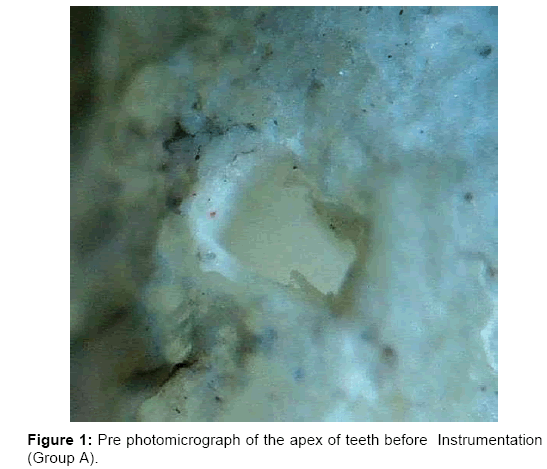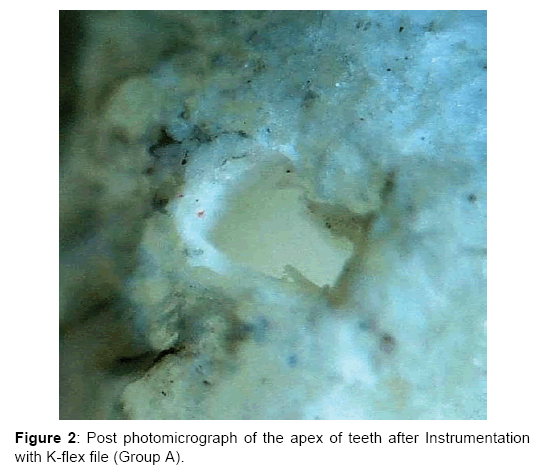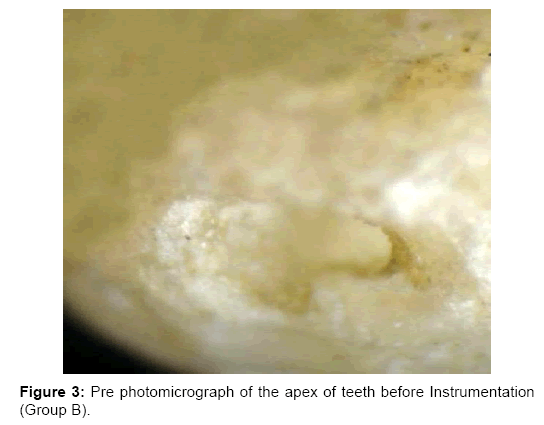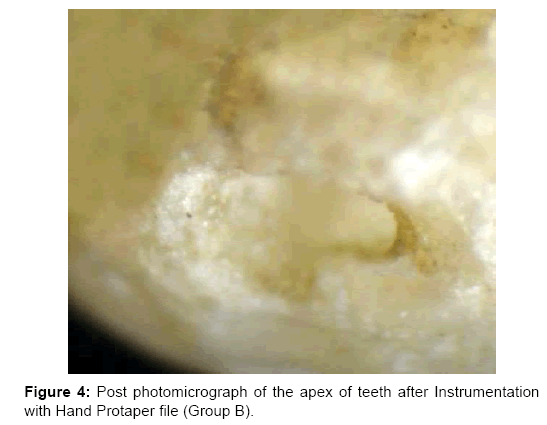To Study the Crack Initiation on the Apical Root Surface Following Different Root Canal Preparation Techniques and Instruments: An In Vitro Study
2 Department of Conservative Dentistry and Endodontics, National Institute of Medical Sciences, Jaipur, India, Email: mathur123@gmail.com
3 Department of Oral and Maxillofacial Surgery, Inderprastha Dental College and Hospital, Ghaziabad, Uttar Pradesh, India, Email: drdeepakpassi@gmail.com
4 Department of Public Health Dentistry, Yogita Dental College and Hospital, Ratnagiri, Maharashtra, India
5 Department of Pedodontics and Preventive Dentistry, Yogita Dental College and Hospital, Ratnagiri, Maharashtra, India
6 Department of Oral Pathology and Microbiology, School of Dental Sciences, Noida, Uttar Pradesh, India, Email: nehasingh244@gmail.com
7 Department of Public Health Dentistry, Rajasthan Dental College, Rajasthan, India
8 Department of Public Health Dentistry, I.T.S Centre for Dental Studies and Research, Ghaziabad, Uttar Pradesh, India
Citation: Singh TK, et al. To Study the Crack Initiation on the Apical Root Surface Following Different Root Canal preparation Techniques & Instruments: An In Vitro Study. Ann Med Health Sci Res. 2018;8:174-178
This open-access article is distributed under the terms of the Creative Commons Attribution Non-Commercial License (CC BY-NC) (http://creativecommons.org/licenses/by-nc/4.0/), which permits reuse, distribution and reproduction of the article, provided that the original work is properly cited and the reuse is restricted to noncommercial purposes. For commercial reuse, contact reprints@pulsus.com
Abstract
Background: Instrumentation of root canals significantly weakens the roots. Root stresses generated from inside the root canal are higher in the apical region. Aims: To compare the effect of different root canal preparation techniques & instruments on the development of apical root cracks. Materials and methods: Forty extracted mandibular premolars were mounted in a resin block with simulated periodontal ligaments and divided into four groups of 10 each (Group A, Group B, Group C, Group D) according to root canal preparation technique and instrument. Group A: The teeth were instrumented with stainless steel K-flex files using a step back technique with balanced force concept, Group B and Group C teeth were instrumented with hand protaper and rotary protaper with crown-down technique, Group D: Teeth were instrumented with rotary K3 system with crown-down technique. Result: 3 apical root cracks were found in Group A (K-flex files) amongst 10 and 1 Apical root crack in Group B (hand protaper). No crack was found in samples among group C and group D. Conclusion: Development of cracks on the surface of the apex during mechanical preparation might lead to future fracture of the tooth structure.
Keywords
Apical root cracks; Instrumentation; Protaper; Step back technique; Vertical root fracture
Introduction
Biomechanical preparation (BMP) is the most critical step for the root canal treatment procedure. The main factor which decides the successful root canal therapy include complete debridement of root canal, bacterial elimination, debris removal and three dimensional obturation of root canal system. During cleaning and shaping of the root canal apical enlargement provides effective cleaning and enough space for effective sealing in the apical region. [1] Kuttler reported that the root canal usually narrows towards the apex and expands to form apical foramen. The distance between apical constriction and apical foramen ranges from 0.5 to 1 mm; thus, the location of apical foramen allows the position of apical constriction to be estimated. [2]
Zandbiglari et al. have studies that improper or excess instrumentation of root canal space significantly weakens the root structure and strength. [3] Stresses created during instrumentation from inside the root canal space are greater in the apex and along the canal walls than on the external root surface. The greater stress distribution in the apical area could lead to the initiation of cracks and a root fracture can occur due to propagation of apical cracks. In a recent study, Soros et al. concluded that complete vertical root fracture is not an instant phenomenon, but it is a result of the gradual diminution of root fracture. [4]
For root canal preparation a variety of instruments both hand held & engine driven are available. Traditionally, root canal preparation was carried out by using stainless steel endodontic hand files. In recent years, advances in rotary nickel-titanium instrument have led to new design and technique of root canal instrument. Rotary NiTi instrument is believed to allow preparation of root canals with fewer procedural errors than conventional stainless steel instruments. [5] In last decade, the reason of popularity of NiTi instruments among the clinician is their high cutting efficiency, greater strength, time saving and rapid availability of a wide range of designs. This study was planned to compare the effect of different root canal preparation techniques & instruments on the development of apical root cracks.
Material and Methods
Mandibular premolars teeth which are freshly extracted and stored in distilled water were randomly selected for this study. Inclusion criteria of straight root and single canal with no resorption and excluded those teeth which were having preexisting apical cracks, curved roots, apical irregularity or open apices. To check the pre-existing apical cracks transmitted light and stereomicroscope under 12x magnification was used. Forty teeth were finally selected and stored in distilled water throughout the study.
Sample preparation
The selected tooth roots were wrapped with aluminum foil & embedded in auto-polymerizing resin (DPI Self-cure Batch no. 161) set in anacrylic tube of diameter of 9 mm and 13 mm height. After polymerization root was then removed from the tube with aluminum foil. The acrylic was cut on the apical end so that 2-3 mm of root apex was exposed to allow intraoperative image recording. Then 2 mm of the crown was removed above the cement enamel junction, to get straightline access and marking reference point. The root surface & the socket were coated with a hydrophilic vinyl polysiloxane impression material & the root was immediately repositioned. Thus, polysiloxane replaced the space created by the foil and will act as an artificial periodontal ligament. Teeth were randomly distributed into four experimental groups of 10 teeth each. Now permanent markings are placed on the acrylic tube to avoid any re-examine error. Single initial photomicrograph of the apex was taken by the stereo microscope (X 40) attached to a digital camera (Zeiss Stemi SV6, Carl Zeiss, Jena, Germany). A size 10 K-file was inserted into the canal & radiographs were taken to confirm the working length up to minor constriction. To establish the patency of the root canal a 15 K-file (Dentsply Maillefer, Ballaigues, Switzerland) were used.
Root canal preparation
Group A: The teeth were instrumented with stainless steel K-flex files (Sybronendo) with non-cutting tip using a step back technique. To enlarge the canal, a balanced force technique [6] was used with successive files placed into the canal, with a clockwise movement of 60- 90 degrees with slight inward pressure. Then counter clockwise movement of 120-180 degree, under apically directed pressure to cut the dentine. Cleaning and shaping of each sample were done till 40 number. All the canals were irrigated with 3% sodium hypochlorite.
Group B: Teeth were instrumented with hand protaper (Dentsply Maillefer, Ballaigues, Switzerland) with crown-down technique. [7] After exploring the root canal space with a stainless steel size 10 file, the S1 file was inserted to enlarge the coronal two-thirds of the canal. Start the ProTaper sequence with S1 file. The apical extent of S1 file will passively follow the portion of the canal and it designed to cut dentin, in a crown down manner. Irrigate, recapitulate with the 10K File to break up debris. The Sx file was then introduced but to no more than two-thirds of the canal depth. When pre-enlargement procedures were finished, a size 15 K-file was used to confirm the working length. The files were then used with the sequence of S1, S2, F1, F2 and F3 files. A clockwise and gently rotating clock wise 45-90 degrees motion were used to cut the dentine.
Group C: Teeth were instrumented with rotary protaper with crown-down technique. [8] The ProTaper rotary files (Dentsply Maillefer) was used with an engine driven Electric Motor (X-Smart, Dentsply Maillefer) with a preset rotational speed 300 rpm with a 16:1 reduction hand piece and 1.6 N/cm torque to prepare the canals. SX file was used to enlarge the coronal portion of the canal. The shaping files (S1, S2) were used with brushing outstroke action for shaping of canals and finally finishing files (F1, F2, F3 with taper 20/7, 25/8, 30/9 respectively) with pecking motion were used. Then sequential files were used till working length were S1, S2, F1, F2 and F3 files (with a taper 0.06 at apex region). Group D: Teeth were instrumented with the K3 rotary nickel-titanium file system (Sybron Endo, Orange California). K3 system (consist of 6 Ni-Ti files) with crown-down technique. Instruments were inserted in apical direction with pecking motion until resistance was felt. For the access in the apical third 30/8 instrument size files were used and the other instruments were used till the apical foramen. The movements which were used for insertion of instruments were with linear back and forth movements without apical pressure till instrument reach the apical foramen. When some resistance was found during instrumentation, the auto reverse mechanism of the device was functionally active. The preparation was completed with a #40, #35, and #30 K3 instrument, with resistance at 300–350 rpm. Each instrument was used for only 5–7 s.
Evaluation
After root canal preparation, the teeth in acrylic tubes were placed under the stereomicroscope with 40x digital zoom to check the presence or absence of cracks originating at the apical foramen by compared with preoperative images of tooth apex. To evaluate the each sample two operators were assigned for identification of crack. A crack was identified as any visible breach or liner fracture on the root surface. McNemar exact test and One-way analysis of variance were used to compare the results. All statistical analysis was performed at a 5% significance level.
Results
As Table 1 summarizes total number of apical cracks which were observed. 3 apical cracks were found in group A which is maximum among all groups [Figures 1 and 2]. In group B, 1 apical crack was found [Figures 3 and 4] while in group C and group D, no crack was found. Logical regression analysis shows that both root canal preparation technique and working length had a significant role on apical crack formation as balanced force technique were used in group A. The pair –wise comparisons between the groups are not statistically significant-
| Sample No. |
Group A ( K-flex file) |
Group B (Hand Protaper) |
Group C (Rotary Protaper) |
Group D (K3 Rotary files) |
|---|---|---|---|---|
| 1 | X | X | X | X |
| 2 | ✓ | X | X | X |
| 3 | X | ✓ | X | X |
| 4 | X | X | X | X |
| 5 | ✓ | X | X | X |
| 6 | X | X | X | X |
| 7 | ✓ | X | X | X |
| 8 | X | X | X | X |
| 9 | X | X | X | X |
| 10 | X | X | X | X |
Table 1: Showing the presence and absence of apical root cracks in different study groups.
3/10 vs. 1/10 P=0.583 (K file vs. Hand ProTaper)
3/10 vs. 0/10 P=0.211 (K file vs. rotary ProTaper & K file vs. K3 file)
1/10 vs. 0/10 P=1.000 (Hand ProTaper vs. Rotary ProTaper & Hand ProTaper vs. K3 file)
To compare the pre and post intra group comparison McNemar exact test (binomial distribution) is used to calculate the p-value. In group A, p=0.045 which are statistically significant while in group B, p=0.125 which are statistically not significant [Table 1].
Discussion
Root canal instrumentation has the potential to induce dentinal damage [9] and to generate cracks on the apical surface which could ultimately lead to the development of vertical root fractures. [10] Root canal instrumentation includes both enlargement and shaping of the root canal system to allow effective disinfection by irrigants and medicaments. [11] The thorough instrumentation of the apical region, recognized as the critical zone for instrumentation, [12] has long been considered to be a crucial factor in the cleaning and shaping process. However, a consensus has yet to be reached for the optimal apical preparation size.
Although some authors advocate a minimally tapered canal avoiding aggressive apical instrumentation, [13] others suggest that root canals be shaped 6 to 8 file sizes larger than the first apical binding file. [14]
A large apical instrumentation size is beneficial in reducing the debris and remaining bacteria, [15] whereas maintaining the canal size as small as practical could reduce the fracture susceptibility. [16] Wu et al. suggested terminating instrumentation 2 to 3 mm and 0 to 2 mm short of the apex for vital pulp and infected canals, respectively. [17] In this study, cracks are found mainly with the use of hand instrumentation while the use of rotary system did not produce any cracks. A significant advance in root canal preparation with hand instruments was made with the introduction of the balanced force movement of files. [18] This technique uses clockwise movement for inserting the file with reaming motion and proceed with an anticlockwise motion for dentine removal. The files must be straight, not precurved, preferably having a non-cutting tip and may be of stainless steel or nickel–titanium. It is an efficient technique and is less likely to cause iatrogenic damage to tooth structure and also aligns the instruments in a central position within the canal space.
The apical pressure used in the balanced force technique might concentrate on the external root surface that surrounds the apical foramen and initiate a crack if the tooth structure is not sufficiently strong. [19] Isom TL et al. reported that the pattern of stress distribution in the apical area could lead to the development of cracks & fracture propagation. [20] The external root stresses caused by stainless steel file used with the balanced force technique was concentrated near the tip of the file. Furthermore, stainless steel files in sizes above 15 or 20 become inflexible and have a tendency to straighten resulting in over-cutting on the outer wall in the apical region and along the inner wall; this might explain why group A showed the highest mean number of cracks.
Protapers are now marketed in plastic handles for use as hand instruments. The biomechanical preparation done in the apical region of the canal is still the topic of debate. Some clinicians thought that it is not utmost require to widen the apical portion of canal because excess flaring and filing will lead to the irrigant migration and agitation in the apical part of the canal [21] while others believes that apical preparation it necessary to remove infected dentine and pulp in the few millimeters of apical part by shaping to at least a size 30 file. [22] In group B with protaper, only 1 crack was found which is statistically insignificant and might be due to iatrogenic defect.
In group 3 and group 4 by using the rotary system no cracks were found because mechanical rotation provides a more constant 360-degree engagement of the file tip in the canal resulting in good accommodation of instrument in the central axis of the canal, thus decreasing the ledge formation or perforation. The flexibility for following the canal allows more conservative in preserving tooth structure while effectively cleaning and shaping the canal.
K3 file system is triple fluted, asymmetric, cut efficiently & safely. Relieved radial angle reduces friction with root canal wall that leads to fewer chances of apical cracks formation. The removal of dentin does not always result in increased fracture susceptibility, which is rather intrinsic to the root and canal morphology and is beyond the control of the clinician. There was, however, an observed tendency in a higher production of cracks when larger file sizes were used. The contact between the instrument and the canal wall creates many stress concentration sites from which a crack may initiate. [23] Further studies are necessary to determine the effect that instrumentation has on crack initiation in teeth with curved canals.
Conclusion
This study focused on the development of cracks on the surface of the apex during mechanical preparation that might lead to future fracture of the tooth structure. Results of this study suggest that irrespective of file design NiTi files can produce various degree of dentinal damage which further results in apical cracks. The result of this study also proves that instrumentation technique alone can cause apical cracks initiation. Furthermore, there are more chances of crack initiation when instrument limit is apical foramen and large number of instrument is used compared with when working length is 1 mm short from apex. The clinical relevance of these apical cracks is that they may further propagate in future can lead to vertical root fracture, which is not an instant phenomenon rather than gradual diminution of tooth structure.
Conflict of Interest
I declare there is no conflict of interest
REFERENCES
- Walton RE, Torabinejad M. Principal and practice of endodontics, 2nd edn. Philadelphia, PA, USA: Saunders, 1996;201-233.
- Gutmann JL, Leonard JE. Problem solving in endodontic working-length determination. Compendium of continuing education in dentistry (Jamesburg, NJ: 1995). 1995;16:288-290.
- Zandbiglari T, Davids H, Schäfer E. Influence of instrument taper on the resistance to fracture of endodontically treated roots. Oral Surg Oral Med Oral Pathol Oral Radiol Endod. 2006;101:126-131.
- Soros CZ, Lambrianidis T, Palaghias G. Spreader load required for vertical root fracture during lateral compaction ex vivo evaluation of periodontal stimulation and fracture load information. Oral Surg Oral Med Oral Pathol Oral Radiol Endod 2008;106:e64-e70.
- Adorno CG, Yoshioka T, Suda H. The effect of root preparation technique and instrumentation length on the development of apical root cracks. Journal of Endodontics. 2009;35:389-392.
- Roane JB, Sabala CL, Duncanson Jr MG. The “balanced force” concept of the instrumentation of curved canals. J Endod 1985;11:203-211.
- Clifford JR. The protaper technique. Endodontic topics 2005;10:187-190.
- West JD. Introduction of a new rotary endodontic system: Progressively tapered files; dentistry today. 2001;20:50-57.
- Bier CA, Shemesh H, Tanomaru-Filho M, Wesselink PR, Wu MK. The ability of different nickel-titanium rotary instruments to induce dentinal damage during canal preparation. J Endod. 2009;35:236-238.
- Er K, Tasdemir T, Siso SH, Celik D, Cora S. Fracture resistance of retreated roots using different retreatment systems. Eur J Dent. 2011;5:387-392.
- Hulsmann M, Peters O, Paul MH. Dummer S. Mechanical preparation of root canals: shaping goals, techniques and means. Endodontic Topics 2005;10:30-76.
- Simon JH. The apex: How critical is it? Gen Dent 1994;42:330-334.
- Buchanan L. Management of the curved root canal. J Calif Dent Assoc 1989;17:18-25.
- Tan BT, Messer HH. The quality of apical canal preparation using hand and rotary instruments with specific criteria for enlargement based on initial apical file size. J Endod. 2002;28:658-664.
- Sathorn C, Palamara JE, Messer HH. A comparison of the effects of two canal preparation techniques on root fracture susceptibility and fracture pattern. J Endod. 2005;31:283-287.
- Ricucci D. Apical limit of root canal instrumentation and obturation, Part 1. Literature review. Int Endod J. 1998;31:384-393.
- Wu MK, Wesselink PR, Walton RE. Apical terminus location of root canal treatment procedures. Oral Surg Oral Med Oral Pathol Oral Radiol Endod. 2000;89:99-103.
- Mayhew JT, Eleazer PD, Hnat WP. Stress analysis of human tooth root using various root canal instruments. J Endod. 2000;26:523-524.
- Blum JY, Machtou P, Esber S, Micallef JP. Analysis of forces developed during root canal preparation with the balanced force technique. Int Endod J. 1997;30:386-396.
- Isom TL, Marshall JG, Baumgartner JC. Evaluation of root thickness in curved canals after flaring. J Endod 1995;21:368-371.
- Stabholz A, Rotstein I, Torabinejad M. Effect of preflaring on detection of apical constriction. J Endod 1995;21:92-96.
- Saunders WP, Saunders EM. Effect of non-cutting tipped instruments on the quality of root canal preparation using a modified double-flared technique. J Endod 1992;18:32-36.
- Kim HC, Lee MH, Yum J, Versluis A, Lee CJ, Kim BM. Potential relationship between design of nickel-titanium rotary instruments and vertical root fracture. J Endod. 2010;36:1195-1199.








 The Annals of Medical and Health Sciences Research is a monthly multidisciplinary medical journal.
The Annals of Medical and Health Sciences Research is a monthly multidisciplinary medical journal.